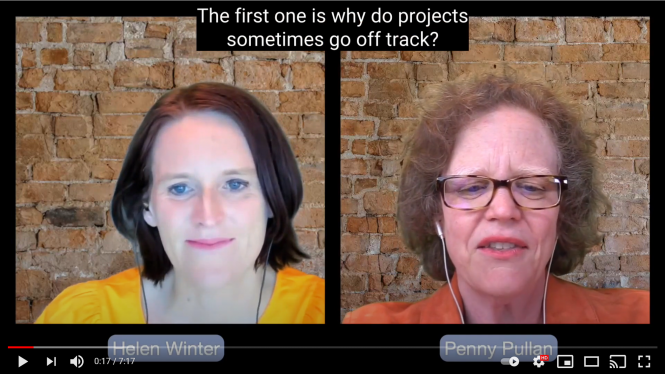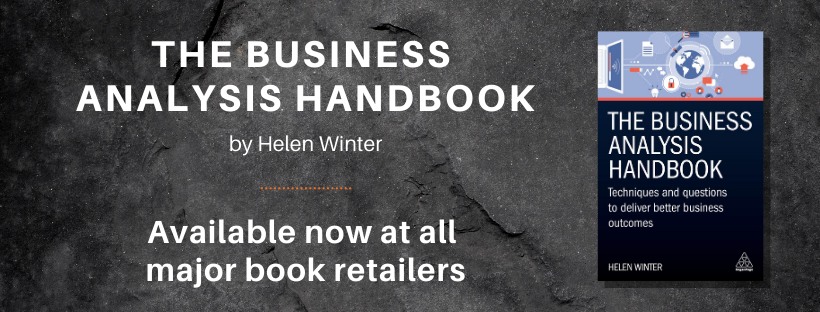
This is aimed at those who are interested in tips for getting a project back on track or for how to start a project safely.
If you are unable to see the video embedded then you can also view through this link.
See below for the transcript.
[00:00:00.560] – Penny
Hi, my name’s Penny Pullan, and I’m here with Helen Winter, who has lots of experience in getting projects back on track. I know you’ve done this many times over the years, Helen, and so I’ve got some questions for you. The first one is why do projects sometimes go off track? What are the main reasons behind that that you see?
[00:00:22.400] – Helen
OK, so some of the main reasons is usually about whether the problems are being understood correctly. Sometimes I’ve found that it’s very easy, especially in the business that day in, day out, they come up with what they think the solution is.
[00:00:39.690] – Helen
And then sometimes the project can be formed around the solution. And what that can mean is that when other people get involved if they don’t understand the problems they’re resolving, they don’t necessarily know whether they’re including everything that needs to be included. So that’s one of the big reasons and sometimes I’ve had to take projects back to understanding the problem to be able to make sure that the communication is there and it’s understood because also the other big thing about understanding the problem first is that you can then articulate what success criteria is, what success looks like.
[00:01:23.520] – Helen
The problem with going straight into the solution is that how do you know you’ve done it right? How do you know that it’s going to benefit the business? How do I know that I’ve made sure that everything’s being taken into account. One project I worked on they thought it was best to go straight to the solution, and then it got all the way to implementing it. And then it was found that it needed customer information from another system.
[00:01:51.510] – Helen
And that had never been thought of and people had been spoken to. And then the architects got brought in too late and then all the deadlines got blown out of the water because this is the way it had been done. They couldn’t actually send the customer information that was needed because that hadn’t been thought of. So it’s so, so important to make sure the problems understood this, that the scopes understood and making sure that the whole solution is included and to then make sure it meets all of the problems and the success criteria properly.
[00:02:22.530] – Helen
So that’s that’s one reason.
[00:02:24.570] – Penny
That’s one reason. OK, keep going then.
[00:02:29.400] – Helen
Another example I was thinking of the day was where there was lots of different parties involved, and it just seemed that we weren’t sure why things weren’t moving. So we had to have lots of meetings to understand why. There was a couple of problems. One was that one of the sets of teams that needed to do something. They didn’t understand what needed to be done.
[00:02:58.470] – Helen
And also the dependencies weren’t understood. So the team were there is no rush we will do that last. And the problem was, is when I looked at it, the very thing they wanted to do last was the thing that everybody else needed to be done first and so all the deadlines would be met. So it’s really important to have a plan as well. Understanding the problem, having a success criteria and having to plan.
[00:03:22.090] – Penny
Absolutely. Wow. OK, so what can you do about it other than bringing you code so people like you.
[00:03:30.760] – Helen
So it’s understanding the problem. The questions that I recommend asking, especially if people are talking or thinking about the solution, is to say, what does that mean to them? What would what would the significance of it have? And to really just keep asking this question over. Why would that make a difference?
[00:03:52.750] – Helen
And why would having this would be to do it? So it’s just a continually asking those questions to get them to go up different levels. Other techniques for understanding the problem, and quite often a lot of stakeholders really know their pain points. They do get what the problems are. They do know them. Sometimes what we’ve done is I’ve got them to do a customer journey or a process map, and then we’ve gone round with everybody. Then we’ve got people to highlight where their particular pain points are.
[00:04:24.910] – Helen
So there the sort of techniques you can do for understanding a problem. And then in terms of making sure people understand what order things need to be done in. One of the techniques that I used recently really effectively was to do a dependency map. I used to use Post-it notes where you can stick things and move things around but because of virtual working I just used PowerPoint and then was able to move the notes around in PowerPoint to get the dependencies.
[00:05:00.980] – Helen
So that was quite good because it got everybody across the different teams that we were able to kind of show me yeah that has to be done before that. We then had to draw it all out. And that then enabled me to put a plan together. And then that was really good then because once I had put that all into a plan the teams could then see if they didn’t provide it by the deadline, then it affected everything else.
[00:05:23.680] – Helen
They hadn’t got that appreciation before.
[00:05:26.470] – Penny
A visual way of being able to see things is so powerful, isn’t it?
[00:05:31.090] – Helen
Yeah. Yeah. And I mean, I actually gave them a copy of the plan so they could actually just put in a change of date. So if they actually said, OK, what about this date instead they could put it in themselves, they could see the knockout impact.
[00:05:43.030] – Penny
Oh, brilliant.
[00:05:44.240] – Helen
That really, really helped. And then the other thing that helped was I put a quality log together. So all the deliverables, we actually stated what the content was for each of the deliverables and that helped a lot because that took away people’s fears of we haven’t been able to do it because we didn’t know what we were meant to do and that kind of stopped that straight away. And once we’ve got those things in place. It worked like a dream. They absolutely did sort of like the regular updates, you could just completely change the situation. Everyone knew what they were doing when it needed to be done, what they were doing. And it came in, worked on time, met all the deadlines. So it made such a difference.
[00:06:28.010] – Penny
Hmm, sounds like you made all the difference.
[00:06:32.710] – Helen
Yeah, it’s just it’s just putting those just those techniques making sure they are in place.
[00:06:37.130] – Penny
OK, brilliant, OK, Helen, so thank you very much for answering the questions. How can people find out more and get in touch with you if they’d like to?
[00:06:50.370] – Helen
OK, so if people want more detail about some of the things we’ve been talking about, I’ve got a book called the business analysis handbook that you can read. It’s a good reference book. If they need some some help from me personally they can get in touch with me through either LinkedIn or my business email address at [email protected].
[End of transcript]
Thoughts? Questions? Please share in the comments.
If you have found this article useful then you might like my book – The Business Analysis Handbook – Techniques and Questions for better Business Outcomes. The book is available from www.koganpage.com and all major print and e-book retailers.

